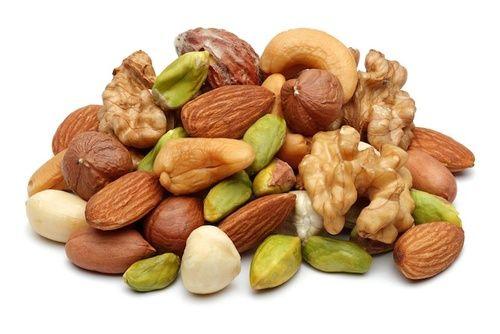I oil seeds, also known as dried fruit, are useful for cardiovascular diseases and for diabetes thanks to their many properties. Let's find out when and how to use them.
> Properties and benefits
> Oilseeds, allies of
> How to store them
> Curiosities about oil seeds

What are oilseeds
Oil seeds (or dried fruit) should not be confused with dried fruit. Specifically, there are two categories:
- nuts, also called oily fruit (walnuts, hazelnuts, almonds, cashews, peanuts, etc.) because they are generally well supplied with oils, reserve energy for the future plant;
- pulpy dried fruit (plums, dates, apricots, figs, bananas, etc.) which instead undergoes various dehydration treatments, some of which are very old, such as natural drying in the sun, or in artificially heated environments with hot air through dryers and ovens.
Some fruits such as peanuts and pistachios which, although they do not fall into the category from a botanical point of view, in fact, are characterized by a similar nutrient content and a similar external appearance.
Properties of oil seeds
Useful supplements in the diet of vegetarians and sportsmen, these fruits provide our body with many beneficial properties, thanks also to the presence of proteins, vitamins, mineral salts, essential fats, fibers and sugars.
I grassi that they contain (unsaturated and polyunsaturated fats, in particular omega-3 and omega-6) are not only without cholesterol but even capable of reducing the amount of the latter in the body, protecting the arteries from atherosclerosis thanks to their ability to lower the levels of "bad" cholesterol (LDL) and promote the increase of "good" cholesterol (HDL) .
While considering the high intake of lipids, they provide a fair amount of proteinin fact, in every 100 g of oily fruit we find 31,9 g of protein in pine nuts, 29 g in peanuts, 22 g in almonds, 18,1 g in pistachios compared to the 15-20 g of average protein content of meat and fish. They are therefore an excellent source of vegetable protein to be used as a possible alternative to meat or fish.
Furthermore, among the Vitamins (in particular of group B and vitamin E) and i mineral salts (selenium, potassium, zinc, magnesium, manganese and copper) contained in dried fruit, there are many antioxidant substances capable of fighting free radicals. Calcium is present in particular in almonds, phosphorus in pistachios and pine nuts, iron in peanuts and hazelnuts.
Another plus is the good amount of fiber present in these foods (e.g. almonds 14 g per 100 g), which improves the functionality of the intestine by promoting peristalsis and intestinal transit and makes these oil seeds easily digestible: those suffering from constipation should supplement breakfast with some walnuts or almond. A habit also useful for improving insulin response in diabetics.
As a mid-morning snack, taken to school or work, dried fruit is ideal for everyone, as it is a concentrated energy psychophysics (on average 600 kcal per 100 g of food) but above all a study has shown the positive influence of essential fats, of which dried fruit is particularly rich, on the ability to learn and pay attention. Already the ancients, who studied colors and shapes of plants to identify their properties, had noticed the similarity between the kernel of the walnut and the shape of the human brain: therefore they recommended this fruit to improve the intellectual faculties.
With this mix of beneficial properties we can therefore consider dried fruit one of the main Functional food or "functional food" that must never be missing on our tables.
You can learn more about all the causes and natural remedies for diabetes treatment

Allies of
Dried fruit was the first food to receive the claim "good for the heart”By the US Food and Drug Administration. In a recent study, conducted on 6309 diabetic women at high risk of heart attack and with a follow-up at 22 years, it was evident that the regular consumption of dried fruit reduced the incidence of heart attack by up to 44% in women. regular, daily consumers of dried fruit.
A reduction of cardiovascular diseases, above all thanks to its anti-atherosclerotic action, it is attributable to the high intake provided by omega-3 fats (they contain a greater quantity than salmon) and antioxidants such as polyphenols (they contain a greater quantity than red wine).
According to the British Journal of Nutrition four handfuls of walnuts, almonds o peanuts per week reduce the risk of cholesterol-related heart disease by 37% because they raise HDL levels and reduce LDL levels.
The high fat content of dried fruit has long suggested that its use leads to weight gain but this has never been observed experimentally. The introduction of dried fruit, in all studies, was not only never associated with weight gain but, if anything, with a small decrease, sometimes statistically significant in others not.
The reason is not yet clear but some authors have observed a sharp increase in satiety, a certain increase in basal metabolic rate and a certain inability of the organism to fully utilize the calories of this food. For this reason, the use of dried fruit has also become recommended practice for people with obesity problems.
How to store oil seeds
Usually, the seeds that form nuts already reach the optimum level of moisture and ripeness on the plant.
It is important to remember that dried fruit, despite being preserved for a long time, requires special attention in conservation due to the fats present which tend to go rancid under the action of heat and light (also losing crunchiness).
For this reason it would be appropriate:
- buy vacuum-packed shelled oily fruit and, if not, with the packages well closed;
- dry them lightly in the oven to ensure better conservation;
- do not keep them in the kitchen cupboard but always in a closed container in the refrigerator (especially for walnuts).
Remember that walnuts, almonds and the like should never have a bitter taste (a sign ofrancidity of fats which in this way also become harmful) but a rather sweet aftertaste.
Curiosity
Certainly the many calories present in these tempting foods cannot be denied and the paradox is that, despite being available on the market all year round, traditionally we consume dried fruit almost exclusively during the Christmas holidays, a period in which it is well known it is customary to have a "full" of foods rich in calories and, what is worse, at the end of "rich" dishes with the risk of burdening digestion.
Oilseeds are therefore to be considered not only a treat to munch on during the Christmas period but a real mine of nutritional properties to be use all year round.
READ MORE
Oil seeds among the ingredients of the diet according to the kousmine method


























